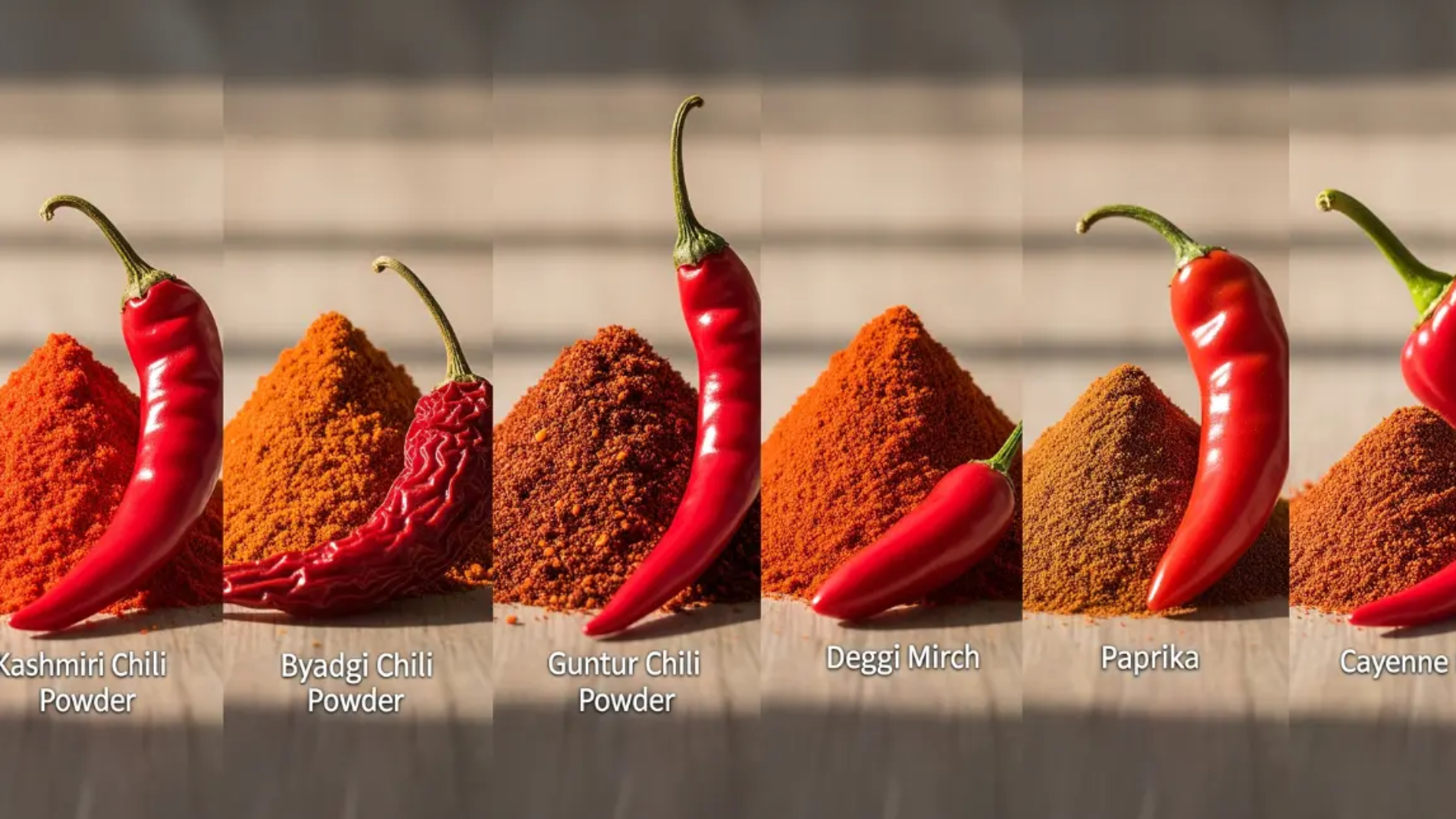When a recipe calls for chilli powder, it’s easy to assume that any red powder from the spice aisle will do. However, in the world of spices, and especially in India—the global heartland of chillies—that couldn’t be further from the truth. The term “red chilli powder” encompasses a dazzling spectrum of flavours, colours, and, most famously, heat levels.
Each variety of Indian chilli powder has a unique identity, cultivated for a specific purpose. Some are grown for their scorching pungency, while others are prized for their brilliant red colour and mild taste. Understanding these differences is the key to mastering flavour and creating dishes and products with precision. This guide will explore five of the most prominent types of lal mirch powder that every chef, food manufacturer, and spice enthusiast should know.
Byadgi Chilli Powder: The Colour King
Hailing from the state of Karnataka, Byadgi (or Bydagi) is one of the most sought-after chillies in India, renowned for its stunning colour rather than its heat.
Heat Level (SHU): Very Mild (15,000 – 25,000 SHU)
Colour Value (ASTA): Extremely High (150 – 200 ASTA)
Flavour Profile: Subtly smoky and sweet.
Best For: Byadgi is the secret ingredient for achieving a deep, natural red colour in dishes without adding overwhelming heat. It’s a favourite for use in pickles, spice blends (masalas), and snack seasonings where appearance is paramount. Food manufacturers love it as a natural colouring agent.
Guntur Sannam Chilli Powder: The Versatile Workhorse
From the Guntur district of Andhra Pradesh, a region famous for its chilli cultivation, comes the Guntur Sannam. This is one of the most widely used and exported chillies from India.
Heat Level (SHU): Medium-Hot (35,000 – 45,000 SHU)
Colour Value (ASTA): Medium (50 – 80 ASTA)
Flavour Profile: A sharp, pungent flavour.
Best For: Its balanced profile of heat and colour makes Guntur Sannam incredibly versatile. It’s the go-to chilli powder for traditional South Indian cuisine, perfect for adding a robust kick to curries, sauces, and savoury dishes. It provides a solid, reliable heat that is noticeable but not overpowering.
Spice Up Your Business with Authentic Indian Flavors
Import and Export Excellence from India!

Teja Chilli Powder: The Fiery Powerhouse
Also a star of the Guntur region, the Teja chilli is for those who crave serious heat. It is one of India’s hottest chillies and is a major export commodity, prized for its extreme pungency.
Heat Level (SHU): Very Hot (70,000 – 100,000 SHU)
Colour Value (ASTA): Medium (50 – 70 ASTA)
Flavour Profile: Intensely sharp and fiery.
Best For: Teja is the top choice for making hot sauces, spicy condiments, and international cuisines that demand a powerful, scorching heat. Food manufacturers use its extract (oleoresin) for precise heat control in products like spicy snacks and ready-to-eat meals.
Kashmiri Chilli Powder: The Mild & Vibrant Garnish
As the name suggests, this chilli comes from the Kashmir region. It is perhaps the most famous Indian chilli internationally, celebrated almost exclusively for its colour.
Heat Level (SHU): Extremely Mild (1,000 – 2,000 SHU)
Colour Value (ASTA): High (100 – 140 ASTA)
Flavour Profile: A very mild, slightly fruity and smoky taste.
Best For: Kashmiri chilli powder is used when you want the brilliant red hue of chillies with almost no heat. It is the signature ingredient for colouring dishes like Tandoori chicken, Rogan Josh, and various curries, giving them an inviting and vibrant appearance without scaring away those with a milder palate.
Mundu Chilli Powder: The Aromatic & Unique
Grown primarily in Tamil Nadu, the Mundu chilli is small, round, and less common than the others, but it holds a special place in South Indian kitchens.
Heat Level (SHU): Mild (10,000 – 30,000 SHU)
Colour Value (ASTA): Low-Medium (30 – 50 ASTA)
Flavour Profile: A unique, highly aromatic, and slightly tangy flavour.
Best For: The Mundu chilli is prized for its distinct aroma. It is often used whole in tempering (tadka) for dishes like sambar and chutneys. The powder is used in spice blends where a unique, tangy flavour note is desired over pure heat or deep colour.
Spice Up Your Business with Authentic Indian Flavors
Import and Export Excellence from India!

Choosing the Right Chilli Powder
The journey through the world of Indian chilli powder reveals a rich tapestry of flavour, heat, and colour. The perfect choice depends entirely on your goal. Whether you need the fiery kick of Teja for a hot sauce or the brilliant, gentle blush of Kashmiri for a signature curry, understanding these varieties is the first step. The next is to partner with trusted chilli powder exporters who can deliver the pure, authentic version of each, ensuring your final product is exactly as you envision.
Frequently Asked Questions (FAQs)
1. What is the hottest Indian chilli powder?
The Teja chilli powder is one of the hottest commercially grown varieties in India, often reaching up to 100,000 Scoville Heat Units (SHU).
2. Which chilli powder is best for just colour and almost no heat?
Kashmiri chilli powder is the ideal choice. It provides a vibrant, beautiful red colour with a very mild heat level, typically below 2,000 SHU.
3. What does SHU mean?
SHU stands for Scoville Heat Units. It is the universal measurement of the pungency or “hotness” of a chilli pepper. A higher SHU number means a hotter chilli.
4. What is ASTA and why does it matter for chilli powder?
ASTA stands for the American Spice Trade Association. The ASTA Colour Value is a scientific measurement of the extractable colour in a spice. For chilli powder, a higher ASTA value means a deeper, more vibrant red colour, which is a key quality indicator for many applications.
5. Can I blend different chilli powders?
Absolutely! Many famous spice blends and restaurant dishes use a mix of chilli powders to achieve a perfect balance of heat and colour. For example, blending Guntur Sannam (for heat) with Byadgi (for colour).
6. Is Indian chilli powder the same as paprika?
While both are red powders from peppers (Capsicum annuum), they are different. Paprika is typically made from milder, sweeter peppers and is known for its colour and smoky flavour. Indian chilli powders are generally hotter and made from different cultivars.
7. How can I tell if a chilli powder is pure?
Pure chilli powder should have a vibrant, natural colour and a strong, characteristic aroma. Be wary of powders that look unnaturally bright red (potential artificial colour) or feel gritty (potential brick powder). Sourcing from a certified supplier with a lab report (COA) is the safest way to ensure purity.
8. Which chilli powder is most commonly used in everyday Indian cooking?
The Guntur Sannam chilli powder is arguably the most common all-purpose variety used in homes and restaurants across India due to its excellent balance of medium heat and good colour.



Leave A Comment